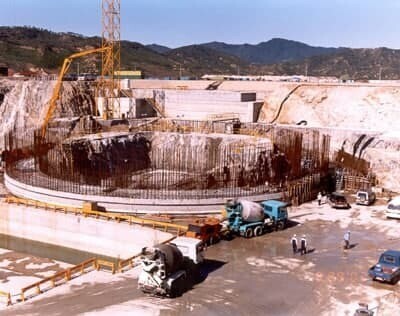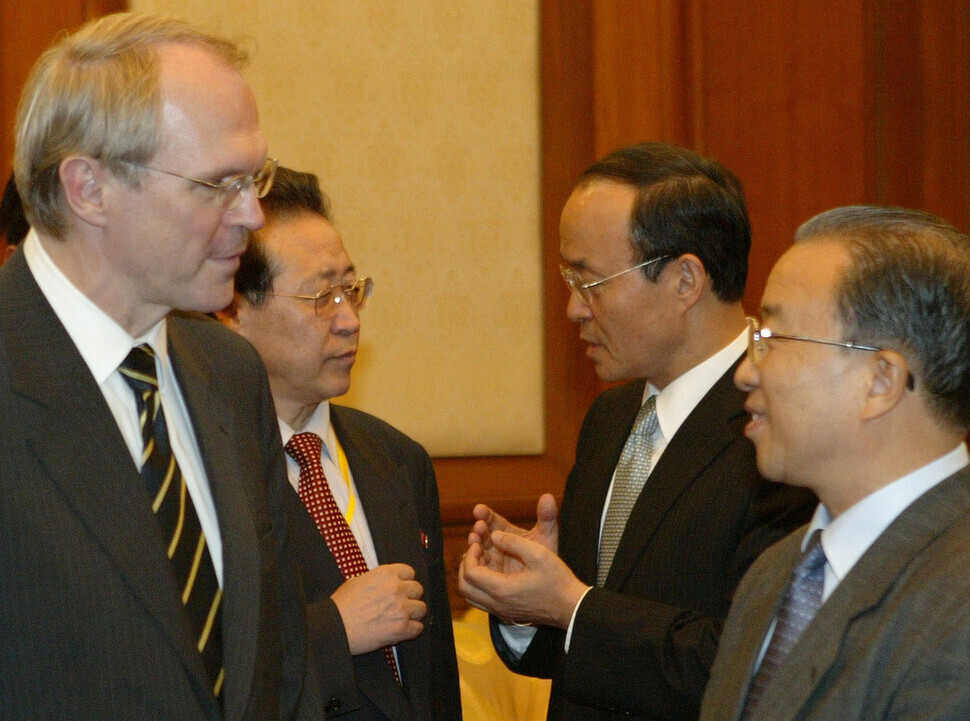hankyoreh
Links to other country sites 다른 나라 사이트 링크
[News analysis] Three reasons the North Korean nuclear plant scandal is overblown
2) Seoul and Pyongyang have never discussed nuclear power cooperation at the bilateral level
3) Nothing of the sort would be possible unless the US and UN ease their current tough sanctions on N. Korea

Over the past few days, South Korean politics have been consumed by allegations that the Moon administration sought to help North Korea build a nuclear power plant. But the whole thing is a classic example of a fake controversy.
First of all, building a nuclear power plant (more specifically a light water reactor) has long been one of the rewards offered by the US and the international community for North Korea’s denuclearization. Second, the idea has never been officially raised or discussed as a bilateral cooperation project by South and North Korea. Third, the project would be impossible without easing or relaxing the US and UN’s tough sanctions on the North.
To elaborate on the first point, the international community promised to build light water reactors for North Korea if it followed through on denuclearization. In fact, construction actually began on a nuclear power plant in Sinpo, Pukchong County, South Hamgyong Province.
That promise was part of the Agreed Framework, which the US and North Korea reached in Geneva on Oct. 21, 1994. Section I.1 of the agreement stated that the “US will undertake to make arrangements for the provision to the DPRK [North Korea] of a LWR [light water reactor] project with a total generating capacity of approximately 2,000 MWE by a target date of 2003.”

As a result, the US, South Korea, Japan and the EU established the Korea Peninsula Energy Development Organization, which broke ground on two 1,000-megawatt nuclear power stations during the presidency of Kim Young-sam. Kim, as it happens, was a member of the Democratic Liberal Party – the forerunner of today’s People Power Party (the opposition party that has been making such a stink about the allegations).
South Korea agreed to pay 70% of the cost of building the nuclear plant on the condition that the light water reactors use a South Korean design. Concrete was poured for the Sinpo plant on Aug. 7, 2002, but construction ground to a halt during the second North Korean nuclear crisis.
The idea of the light water reactors was brought up again during the Six Party Talks. “The DPRK stated that it has the right to peaceful uses of nuclear energy. The other parties expressed their respect and agreed to discuss, at an appropriate time, the subject of the provision of light water reactor [sic] to the DPRK,” the parties involved said in a joint statement issued on Sept. 19, 2005.
Beginning with former president Chun Doo-hwan’s proposal on Feb. 1, 1982, for Seoul and Pyongyang to cooperate on 20 provisional projects, the two sides have discussed and carried out various projects, including highway and railroad links and the joint development of natural resources. But they’ve never discussed building a nuclear power plant at the bilateral level, and that’s not likely to change until decisive progress is reached on the question of North Korea’s denuclearization.
Most importantly, the US and UN’s harsh sanctions on North Korea thoroughly block cooperation projects with the North. Even international programs providing humanitarian aid for North Korea – with the aim of preventing infectious diseases and giving pregnant women and infants the nutrients they need – must receive sanctions waivers from the UN Security Council Sanctions Committee on North Korea.
On a technical level, the US possesses the key technology for the “Korean” light water reactors. In short, the South Korean government couldn’t move ahead with developing such reactors without the US’s cooperation and consent, even presuming that sanctions on North Korea were eased or lifted.
That said, the nuclear reactors are likely to be discussed as a carrot that the international community could offer North Korea in exchange for meaningful steps toward denuclearization. First, though, the nuclear talks that broke down during the North Korea-US summit in Hanoi in February 2019 would need to resume.
By Lee Je-hun, Senior Staff Writer
Please direct comments or questions to [english@hani.co.kr]

Editorial・opinion
![[Editorial] Perilous stakes of Trump’s rhetoric around US troop pullout from Korea [Editorial] Perilous stakes of Trump’s rhetoric around US troop pullout from Korea](https://flexible.img.hani.co.kr/flexible/normal/500/300/imgdb/original/2024/0509/221715238827911.jpg) [Editorial] Perilous stakes of Trump’s rhetoric around US troop pullout from Korea
[Editorial] Perilous stakes of Trump’s rhetoric around US troop pullout from Korea![[Guest essay] Preventing Korean Peninsula from becoming front line of new cold war [Guest essay] Preventing Korean Peninsula from becoming front line of new cold war](https://flexible.img.hani.co.kr/flexible/normal/500/300/imgdb/original/2024/0507/7217150679227807.jpg) [Guest essay] Preventing Korean Peninsula from becoming front line of new cold war
[Guest essay] Preventing Korean Peninsula from becoming front line of new cold war- [Column] The state is back — but is it in business?
- [Column] Life on our Trisolaris
- [Editorial] Penalties for airing allegations against Korea’s first lady endanger free press
- [Editorial] Yoon must halt procurement of SM-3 interceptor missiles
- [Guest essay] Maybe Korea’s rapid population decline is an opportunity, not a crisis
- [Column] Can Yoon steer diplomacy with Russia, China back on track?
- [Column] Season 2 of special prosecutor probe may be coming to Korea soon
- [Column] Park Geun-hye déjà vu in Yoon Suk-yeol
Most viewed articles
- 160% of young Koreans see no need to have kids after marriage
- 2‘Free Palestine!’: Anti-war protest wave comes to Korean campuses
- 3Behind-the-times gender change regulations leave trans Koreans in the lurch
- 4In Yoon’s Korea, a government ‘of, by and for prosecutors,’ says civic group
- 5[Editorial] Perilous stakes of Trump’s rhetoric around US troop pullout from Korea
- 6Korean president’s jailed mother-in-law approved for parole
- 7Nuclear South Korea? The hidden implication of hints at US troop withdrawal
- 8[Photo] ‘End the genocide in Gaza’: Students in Korea join global anti-war protest wave
- 9Yoon’s revival of civil affairs senior secretary criticized as shield against judicial scrutiny
- 10Family that exposed military cover-up of loved one’s death reflect on Marine’s death